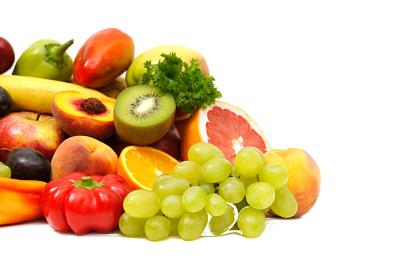
THE GASTRO-INTESTINAL TRACT

Copyright © 2013 All rights reserved. Dietician/Nutritionist Khan - Sitemap
WebDen Website Design en Hosting - Website ontwerp door: www.designer-dragonfly.nl
WebDen Website Design en Hosting - Website ontwerp door: www.designer-dragonfly.nl


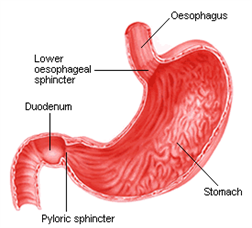
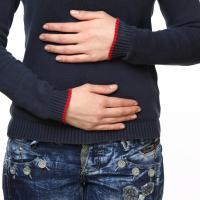
Flatulence and heartburn symptons:
Constipation or diarrhea also causes flatulence which cause abdominal pain and cramps. The
stomach produces acid, which has an antibacterial effect on the food and fluid in the stomach.
The lining of the stomach is protected against the action of the acid, but there may be problems
if the gastric contents enter parts of the gastrointestinal tract which are not acid resistant. This
can happen if too much acid is produced or when the acid resistance of the stomach itself is
reduced. The symptoms of heartburn is a burning sensation and sometimes nausea and acid
regurgitation. Excessive use of alcohol, coffee, sharp and acidic foods such as chutney and
masala, and fried foods as bara, samosa, pakora and kebabs, can aggravate heartburn
symptoms.
The following foods can cause flatulence and gas: cabbage, onions,leeks, raw vegetables and
beans. In addition, combinations of dairy products and juices also cause gas. Not only food, but
also by anxiety,or stress may cause flatulence.
Irritable Bowel Syndrome (IBS)
Irritable bowel syndrome is also known as spastic colon. The causes of irritable bowel syndrome are abnormal bowel habit, lactose intolerance, hypersensitivity to gluten (celiac disease), malignancy, anxiety disorder or depression symptoms. The most common symptoms are abdominal pain, abdominal cramps, rumblings, bloated feeling, flatulence and constipation. These symptoms are reduce after bowel movements. Healthy eating habits, sufficient exercise and the presence of sufficient moisture and fiber in the diet are recommended.
Lactose-intolerance (lactase Deficiency)
Cow's milk contains lactose (milk sugar) which is digested and absorbed by means of the lactase enzyme in the gastro-intestinal tract. With a shortage of lactase, lactose is not sufficiently digested and one gets nausea, flatulence, abdominal cramps and diarrhea. The degree of a intolerance is dependant on the amount of lactose which one can easily digest. Tolerance levels in patients vary from person to person and needs to be individually tested through trial. We recommend the use of lactose free products such as soymilk and other soy products such as soy yogurt, sojavla, soy pudding, tofu etc.
Irritable bowel syndrome is also known as spastic colon. The causes of irritable bowel syndrome are abnormal bowel habit, lactose intolerance, hypersensitivity to gluten (celiac disease), malignancy, anxiety disorder or depression symptoms. The most common symptoms are abdominal pain, abdominal cramps, rumblings, bloated feeling, flatulence and constipation. These symptoms are reduce after bowel movements. Healthy eating habits, sufficient exercise and the presence of sufficient moisture and fiber in the diet are recommended.
Lactose-intolerance (lactase Deficiency)
Cow's milk contains lactose (milk sugar) which is digested and absorbed by means of the lactase enzyme in the gastro-intestinal tract. With a shortage of lactase, lactose is not sufficiently digested and one gets nausea, flatulence, abdominal cramps and diarrhea. The degree of a intolerance is dependant on the amount of lactose which one can easily digest. Tolerance levels in patients vary from person to person and needs to be individually tested through trial. We recommend the use of lactose free products such as soymilk and other soy products such as soy yogurt, sojavla, soy pudding, tofu etc.
Crohn's disease
Crohn's disease is a chronic inflammation of the small or the large intestine, and in particular located in the last part of the ileum (small intestine), or in the colon (large intestine). The most common symptoms are abdominal pain, diarrhea, bloating, fatigue and weight loss. The cause of Crohn's disease is however not known, but stress and the increase of cigarette smoking increases the probability of the occurrence of Crohn's disease. Both genetic and environmental factors may play a role in the etiology of this disease.
Ulcerative ulserosa
This is a chronic inflammation of the mucous membrane in the large intestine. Known symptoms of colitis are abdominal pain, diarrhea, difficulty in passing a stool and sometimes blood loss through the stool. The cause of the disease is unknown, but environmental factors and genetic factors may play a role in the etiology of this disease. The purpose of good of nutrition in colitisulserosa is to maintain a good nutritional status and loss of fluid, electrolytes, and maintain a good level of iron in the body. In principle, all foods may be consumed, however we do recommend avoiding the gas forming foods such as cabbage, leeks, onion, garlic, sprouts, legumes (dahl), beer, fish, eggs and carbonated beverages. It is recommended to eat small regular meals and to avoid large meals. Individual dietary counseling is advisable in order to be advised on which products and foods to avoid to prevent abdominal cramps and abdominal pain. When complications ocurr, the diet needs to be adjusted individually.
Celiac disease (gluten hypersensitivity)
Celiac disease is an inherited disease in which there is an intolerance to gluten (gliadin). This is a protein which is present in wheat, rye, spelt, kamut and barley. Celiac disease causes a degradation of the intestinal villous atrophy and intestinal mucosa, causing malabsorption. Celiac disease can manifest at any age. The diagnosis can be supported by laboratory determination of anti-endomysium antibodies antigliadine. A gluten free diet in both children and adults is an necessary. It is found that children with Down syndrome commanly have have celiac disease. An early diagnosis of celiac disease is not only important to an prevention of unnecessary growth retardation but also in relation to the increased risk of cancer. This means that gluten needs to be removed from the diet completely . Celiac disease can sometimes be fatal, particularly in adults with a severe form of this disorder. Foods made from wheat, barley, kamut, spelled and rye products should be replaced with corn, rice, buckwheat, millet, and teff.
Crohn's disease is a chronic inflammation of the small or the large intestine, and in particular located in the last part of the ileum (small intestine), or in the colon (large intestine). The most common symptoms are abdominal pain, diarrhea, bloating, fatigue and weight loss. The cause of Crohn's disease is however not known, but stress and the increase of cigarette smoking increases the probability of the occurrence of Crohn's disease. Both genetic and environmental factors may play a role in the etiology of this disease.
Ulcerative ulserosa
This is a chronic inflammation of the mucous membrane in the large intestine. Known symptoms of colitis are abdominal pain, diarrhea, difficulty in passing a stool and sometimes blood loss through the stool. The cause of the disease is unknown, but environmental factors and genetic factors may play a role in the etiology of this disease. The purpose of good of nutrition in colitisulserosa is to maintain a good nutritional status and loss of fluid, electrolytes, and maintain a good level of iron in the body. In principle, all foods may be consumed, however we do recommend avoiding the gas forming foods such as cabbage, leeks, onion, garlic, sprouts, legumes (dahl), beer, fish, eggs and carbonated beverages. It is recommended to eat small regular meals and to avoid large meals. Individual dietary counseling is advisable in order to be advised on which products and foods to avoid to prevent abdominal cramps and abdominal pain. When complications ocurr, the diet needs to be adjusted individually.
Celiac disease (gluten hypersensitivity)
Celiac disease is an inherited disease in which there is an intolerance to gluten (gliadin). This is a protein which is present in wheat, rye, spelt, kamut and barley. Celiac disease causes a degradation of the intestinal villous atrophy and intestinal mucosa, causing malabsorption. Celiac disease can manifest at any age. The diagnosis can be supported by laboratory determination of anti-endomysium antibodies antigliadine. A gluten free diet in both children and adults is an necessary. It is found that children with Down syndrome commanly have have celiac disease. An early diagnosis of celiac disease is not only important to an prevention of unnecessary growth retardation but also in relation to the increased risk of cancer. This means that gluten needs to be removed from the diet completely . Celiac disease can sometimes be fatal, particularly in adults with a severe form of this disorder. Foods made from wheat, barley, kamut, spelled and rye products should be replaced with corn, rice, buckwheat, millet, and teff.
Gastrointestinal problems
There are several unpleasant symptoms of gastrointestinal problems: abdominal pain, heartburn, nausea, bloating, abdominal cramps, vomiting, rumbling gut rot, gas and flatulence. Research shows that a glass of luke warm water after a meal has a favorable effect on the gastric acid. A daily bowel movement is very important for health. Normally, one meal takes approximately 2 days (48 hours) to leave the body. Usually, constipation is caused by a lack of physical exercise and/or too little fiber and fluids in the diet. Another cause is a malfunctioning liver (bile salts). Alcohol and caffeine drinks work as diuretics, which may worsen constipation.
Constipation
According to Ayurveda the main causes of diseases causes by disturbed digestive system are lifestyle, unhealthy diet, diet and pent-up emotions, causing an accumulative fermentation processes which causes all kinds of toxins in the body, which in turn lead to a variety of disease. Good eating habits and healthy food to ensure optimal digestive system, result in optimal health. In short, good digestion is on the basis of good health.
The stool should arise naturally, without forcing it. The stool is stimulated by drinking sufficient water and consuming fiber rich foods. Stool is also stimulated by daily yogurt and other sour milk products and avoiding processed products. Numerous studies have shown that carbonated soft drinks such as cola, fanta and 7-up have a negative impact on the daily defecation.
Fibres present in dahl (legumes), vegetables, fruits and other foods, should be well chewed. Fibrous foods that are not chewed properly, will cause gas, flatulence,fermentation and bloating.
It is known that we need dietary fibre to promote bowel movements and that it has a positive effect on the bowel function. There is a relationship between the weight of daily bowel movements and the amount of dietary fibre that is consumed per day. You can increase your fibre intake by consuming more whole grains, fruits and fresh vegetables.
However, if one has had a prolonged usage of laxatives, the introduction of a high fibre diet, will not give you immediate results due to the muscle tone of the colon being weakened. A daily bowel movement in a natural way can then only be obtained after a recovery period. In short, a high fibre diet should be combined with adequate water intake and daily exercise (at least 30 minutes).
There are several unpleasant symptoms of gastrointestinal problems: abdominal pain, heartburn, nausea, bloating, abdominal cramps, vomiting, rumbling gut rot, gas and flatulence. Research shows that a glass of luke warm water after a meal has a favorable effect on the gastric acid. A daily bowel movement is very important for health. Normally, one meal takes approximately 2 days (48 hours) to leave the body. Usually, constipation is caused by a lack of physical exercise and/or too little fiber and fluids in the diet. Another cause is a malfunctioning liver (bile salts). Alcohol and caffeine drinks work as diuretics, which may worsen constipation.
Constipation
According to Ayurveda the main causes of diseases causes by disturbed digestive system are lifestyle, unhealthy diet, diet and pent-up emotions, causing an accumulative fermentation processes which causes all kinds of toxins in the body, which in turn lead to a variety of disease. Good eating habits and healthy food to ensure optimal digestive system, result in optimal health. In short, good digestion is on the basis of good health.
The stool should arise naturally, without forcing it. The stool is stimulated by drinking sufficient water and consuming fiber rich foods. Stool is also stimulated by daily yogurt and other sour milk products and avoiding processed products. Numerous studies have shown that carbonated soft drinks such as cola, fanta and 7-up have a negative impact on the daily defecation.
Fibres present in dahl (legumes), vegetables, fruits and other foods, should be well chewed. Fibrous foods that are not chewed properly, will cause gas, flatulence,fermentation and bloating.
It is known that we need dietary fibre to promote bowel movements and that it has a positive effect on the bowel function. There is a relationship between the weight of daily bowel movements and the amount of dietary fibre that is consumed per day. You can increase your fibre intake by consuming more whole grains, fruits and fresh vegetables.
However, if one has had a prolonged usage of laxatives, the introduction of a high fibre diet, will not give you immediate results due to the muscle tone of the colon being weakened. A daily bowel movement in a natural way can then only be obtained after a recovery period. In short, a high fibre diet should be combined with adequate water intake and daily exercise (at least 30 minutes).
The physical health starts with a healthy functioning gastro-intestinal tract.
This is the place where our food is processed and digested. The human body is miraculous and its fascinating how the digestive system is able to process various foods at the same time.
If we want to eat healthy and well, we need to know how the digestive system works. The human digestive system consists of the mouth, esophagus, stomach, small intestine and large intestine. there are other internal organs that are essential for the gastrointestinal tract,namely, the liver, pancreas, gall bladder and salivary glands.
How the the gastrointestinal tract works
The digestive process of the gastrointestinal tract begins in the mouth. According to Dr. Paavo Airola the digestive process even begins when we see (eye contact) and / or smell (odor) our food. During the digestion process, the food is reduced in size and mixed with the digestive juices, which are essential for our digestive enzymes.
This is the place where our food is processed and digested. The human body is miraculous and its fascinating how the digestive system is able to process various foods at the same time.
If we want to eat healthy and well, we need to know how the digestive system works. The human digestive system consists of the mouth, esophagus, stomach, small intestine and large intestine. there are other internal organs that are essential for the gastrointestinal tract,namely, the liver, pancreas, gall bladder and salivary glands.
How the the gastrointestinal tract works
The digestive process of the gastrointestinal tract begins in the mouth. According to Dr. Paavo Airola the digestive process even begins when we see (eye contact) and / or smell (odor) our food. During the digestion process, the food is reduced in size and mixed with the digestive juices, which are essential for our digestive enzymes.
The mouth
As soon as we have food, such as rice or roti, in our mouths, the digestion process of starch begins. The mouth produces saliva during chewing. The saliva contains amylase, an enzyme that breaks down starch into dextrins and maltose. It also keeps the saliva of the tongue, mouth and teeth clean. Dietary fiber as cellulose should be reduced by chewing as there is not digestive enzyme in the body to digest it. That is why fiber is referred to as "indigestible carbohydrates". When a cellulose-containing product is not chewed properly it ferments causing, bloating and flatulence. An effective digestion begins therefore by eating slowly and chewing properly. Peace of mind is essential for optimal digestion and is necessary to prevent indigestion and flatulence. It is said "better a dry piece of bread with love and peace, than a house full of festive meals with strife and stress.
As soon as we have food, such as rice or roti, in our mouths, the digestion process of starch begins. The mouth produces saliva during chewing. The saliva contains amylase, an enzyme that breaks down starch into dextrins and maltose. It also keeps the saliva of the tongue, mouth and teeth clean. Dietary fiber as cellulose should be reduced by chewing as there is not digestive enzyme in the body to digest it. That is why fiber is referred to as "indigestible carbohydrates". When a cellulose-containing product is not chewed properly it ferments causing, bloating and flatulence. An effective digestion begins therefore by eating slowly and chewing properly. Peace of mind is essential for optimal digestion and is necessary to prevent indigestion and flatulence. It is said "better a dry piece of bread with love and peace, than a house full of festive meals with strife and stress.





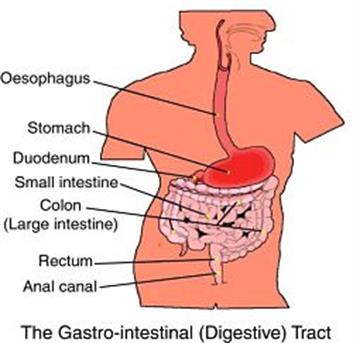

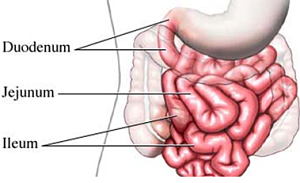

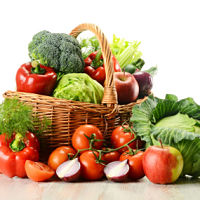
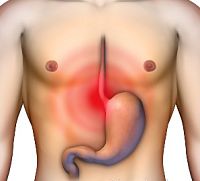
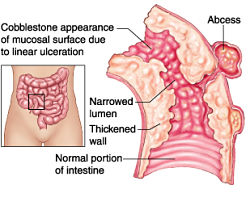

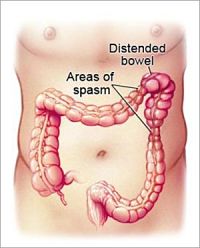
The esophagus
The esophagus is located between the mouth and the stomach. This makes rhythmic and peristaltic wavelike movements to transport the food to the stomach. Peristalsis is controlled by the autonomic nervous system.
The stomach
The stomach is a "J" saclike shape organ that produces various enzymes. In the stomach food is mechanically reduced to very small particles. The stomach wall produces the hormone gastrin. Gastrin stimulates the secretion of various digestive enzymes like pepsin that breaks down proteins, hydrochloric acid (HCl) which destroys unwanted bacteria and an intrinsic factor that is indispensable for the absorption of vitamin B12. For digestion and absorption, the gastrointestinal movements (peristalsis) and the secretion of digestive juices are needed. In this process the gastric emptying proceeds step by step. The small intestine can not handle a large amount of chyme simultaneously. This is why the chyme gradually and slowly enters via the pylorus. On average it takes a meal 3-4 hours to digest and before the stomach is empty. However, if the food is high in fat (oil,butter or margarine, fried foods) the emptying process can take up to 4-5 hours.
The esophagus is located between the mouth and the stomach. This makes rhythmic and peristaltic wavelike movements to transport the food to the stomach. Peristalsis is controlled by the autonomic nervous system.
The stomach
The stomach is a "J" saclike shape organ that produces various enzymes. In the stomach food is mechanically reduced to very small particles. The stomach wall produces the hormone gastrin. Gastrin stimulates the secretion of various digestive enzymes like pepsin that breaks down proteins, hydrochloric acid (HCl) which destroys unwanted bacteria and an intrinsic factor that is indispensable for the absorption of vitamin B12. For digestion and absorption, the gastrointestinal movements (peristalsis) and the secretion of digestive juices are needed. In this process the gastric emptying proceeds step by step. The small intestine can not handle a large amount of chyme simultaneously. This is why the chyme gradually and slowly enters via the pylorus. On average it takes a meal 3-4 hours to digest and before the stomach is empty. However, if the food is high in fat (oil,butter or margarine, fried foods) the emptying process can take up to 4-5 hours.
The small intestine
In average, the length of a small bowel of an adult about 7 meters. The small intestine has three parts: the duodenum, the jejunum and ileum. The small intestine begins at the stomach outlet (pylorus) and runs to the beginning of the colon. In the small intestine the food is digested, the nutrients are absorbed by the blood and then absorbed in the cells of the body. The absorption of nutrients is promoted by the presence of beneficial intestinal bacteria in the small intestine. This flora is very important for the health of the human being.
The large intestine
The large intestine is about 1.5 meters long. After the digestion process is the food goes to the large intestine. In the large intestine, also known as colon, the digestion process is completed. The main task of the colon is the absorb of water and electrolytes. Stool is a waste product of the digestive system. It contains residual toxins, dead bacteria, chyme secretions, cellulose and inorganic substances. The stool is collected in the rectum, the last part of the colon. There are several types of bacteria present in the large intestine. Certain types of bacteria perform beneficial functions for the body. Some species of bacteria produce B vitamins and vitamin K, other fibres break down into gases and acids and yet other species protect the body against certain infections. Residues and undigested food can accumulate in the large intestine. Excess waste and toxins in the gut can cause poisoning of the body. Toxins which are released during the fermentation, pass through the intestinal wall and enter the bloodstream. In chronic constipation the passage time of the stool is too long, and increasing the acidity, resulting the pH being too high. Yogurt contains acid-producing bacteria (Lactobacillus bulgaricus) and this not only enhances the acidity in the colon but also stimulates the bowel movement. People who deal with constipation are advised to eat plums combined with low fat yogurt daily to revitalize the digestive tract. A symptom of intestinal putrefaction is halitosis.
In average, the length of a small bowel of an adult about 7 meters. The small intestine has three parts: the duodenum, the jejunum and ileum. The small intestine begins at the stomach outlet (pylorus) and runs to the beginning of the colon. In the small intestine the food is digested, the nutrients are absorbed by the blood and then absorbed in the cells of the body. The absorption of nutrients is promoted by the presence of beneficial intestinal bacteria in the small intestine. This flora is very important for the health of the human being.
The large intestine
The large intestine is about 1.5 meters long. After the digestion process is the food goes to the large intestine. In the large intestine, also known as colon, the digestion process is completed. The main task of the colon is the absorb of water and electrolytes. Stool is a waste product of the digestive system. It contains residual toxins, dead bacteria, chyme secretions, cellulose and inorganic substances. The stool is collected in the rectum, the last part of the colon. There are several types of bacteria present in the large intestine. Certain types of bacteria perform beneficial functions for the body. Some species of bacteria produce B vitamins and vitamin K, other fibres break down into gases and acids and yet other species protect the body against certain infections. Residues and undigested food can accumulate in the large intestine. Excess waste and toxins in the gut can cause poisoning of the body. Toxins which are released during the fermentation, pass through the intestinal wall and enter the bloodstream. In chronic constipation the passage time of the stool is too long, and increasing the acidity, resulting the pH being too high. Yogurt contains acid-producing bacteria (Lactobacillus bulgaricus) and this not only enhances the acidity in the colon but also stimulates the bowel movement. People who deal with constipation are advised to eat plums combined with low fat yogurt daily to revitalize the digestive tract. A symptom of intestinal putrefaction is halitosis.
The following tips may promote natural bowel movements:
For a good bowel movement one has to consume about 40-50 grams of fiber per day. The prevention of constipation may prevent
colon cancer, because the stool leaves the body quicker allowing the digestive system to be kept clean.
• Eat fresh raw vegetables and at least 2 pieces of fruit per day
• Drink at least 2 litres of water per day. Moreover, drinking hot water is good the gastrointestinal tract
• Eat a bowl (250 ml) dahl soup (use only dahl with meat)
• Eat fresh and varied vegetables daily and use minimal oil in the preparation process
• Always use wholemeal or brown bread and wholemeal flour (atta)
• Eat less meat and more vegetarian products like dhal (with skin) and soy products such as tofu,
tempeh, to-gan, miso, etc
• Use brown/wholemeal atta for roti and/or chapatti
• Use brown rice (brown rice, or red vita rice) and wholemeal pasta (whole wheat macaroni, spaghetti,
noodles, etc
• Minimize oil, chutney and masala
• Exercise daily for at least 30 minutes, for example cycling, brisk walking, jogging, swimming,running, dancing
• Avoid dried food to prevent constipation. An example: dried prunes and figs should be soaked in
water before consuming.



























